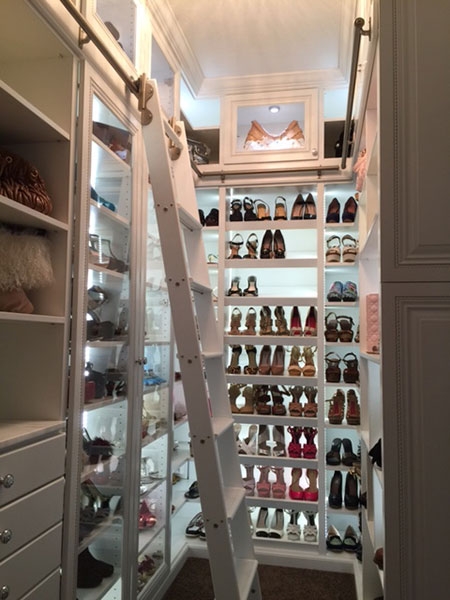Schedule a Free Consult
Schedule Your
Free Design Consultation
Free Design Consultation
To have a closet dedicated solely to shoes and their coordinating accessories is one of the hottest trends in custom closet design right now. These closets frequently contain carefully curated shoe collections accompanied by designer handbags, belts, and other accessories displayed, so they replicate high-end retail stores or quaint boutiques.
The design of these spaces is usually made up of multiple sections of customized shoe shelving. These sections can be either flat and adjustable, slanted with decorative toe stops, sliding for storing pairs front to back, drawers for archiving collectibles, and a host of innovative specialty racks while boots have their own set of organizational particulars. Shoes and boots alike are lovingly laid out providing enough storage to display vast collections in perfect shoe storage solutions.
Design possibilities can be endless when it comes to the display of these well-curated shoes, with the more extensive the collection, the larger the closet needing to be. The goal, of course, is to arrange the footwear so they can to be artfully displayed and admired beautifully. For many fashionistas carving out space to create a shoe closet may have its challenges requiring some forethought and planning. That said shoe curators generally feel the time invested is well worth the task and expense.
Increasing in popularity is the conversion of smaller closets, master bedroom foyers, a wall in a large walk-in, and even smaller secondary bedrooms transforming them into designated shoe storage spaces. Some enthusiasts take their storage one step further by delighting in the creation of a library concept where the closet or micro-space is made up of the floor-to-ceiling shoe and boot shelving sections complete with down-lighting, rolling ladders, and chaise lounges. These custom shoe closets are mostly made up of various types of shelving units that allow one to catalog a small or large collection which offers the illusion of a shoe library.
Men and women alike can identify with the need to properly house their shoes with a system that allows them to display, sort, store, and preserve with ease. As time goes by Americans, have become savvier with how they care for their wardrobe and accessories by taking great care to protect them. With so many brands and styles of fashionable shoes now available, the enthusiast now has a significant investment in designer labels. Jimmy Choo, Gucci, and Bryan Atwood all deserve to be preserved and appreciated for the works of art that they are. These “it” brands include their counterpart designer handbags that are usually paired and coveted.
Quantity
One of the first things to consider when designing the perfect shoe storage system is the size of the shoe collection. The first step is to be realistic about the number of shoes to be stored. Most people have no idea exactly how many pairs of shoes they have or care about because everyday shoes can often be scattered about while others stored in shoe boxes and long forgotten.
Location
Determine the space to work with and exactly what the storage needs are for the complete custom design. Is there a secondary closet that can be converted into a shoe closet and if so, will it be large enough for the entire collection? ¬ Consider if the reach-¬in or is it a walk¬-in be able to accommodate more complex design elements. Perhaps converting a second bedroom into a shoe storage system may be the answer allowing for more room to create specialty pieces like islands, mirrors, and display.
Organization
Assess the different styles and consider how to organize them appropriately. Like styles should be stored together. Create groupings with everything from kitten to high heels, wedges, to flats appropriately, and separate everyday footwear such as athletic shoes and Uggs for an area less visual.
Accessories
Consider the big picture and what else will be stored along with the shoe collection. For woman pairing handbags and shoes is natural while men and woman both like to coordinate belts with footwear. Because it’s custom it’s entirely up to the individual and what makes the most sense. A closet designer can often help determine how much space is left over to fill with similar or complimentary items.
Display
Often thought to be the fun part of the project is selecting the design elements. Features like LED lighting can add emphasis to high-end designer labels, while the style of the shelving structure can be used to showcase brands and shoe styles in fun ways. Consider adding extra flair with painted walls in dramatic or soft color palettes as well as wallpaper before the installation of the system. Create the look and feel of a high-end boutique by adding glass shelves for favorite pairs of shoes while hanging designer boots to show them best off. To create a more masculine space, utilize darker wood paneling and mirrors to add the illusion of space and the opportunity to check your entire look before rushing out the door.
And why we love it!
Download these free guides.
Each of our custom systems is completely personalized and begins with a complimentary design appointment.
Schedule a ConsultDuring the consultation you and a designer will discuss your expectations, desires, and project budget, with the aim of designing an organization system that will:
